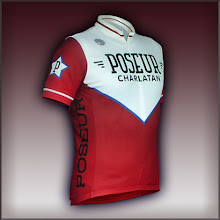Oh I had a good post planned! There is a catch-22 situation in town, and I captured it by digital photographs- and I had a serendipitous encounter with scofflaw cyclists, capturing automobile/bicycle conflicts as they scraped along the curb face...
But alas, I inadvertently deleted the files simultaneously from my hard drive and my camera. (What tha...?!) I won't be doing that again, and I am (Once again!) mourning the truism that education is always expensive!
So, a blog about odds and ends!
RANTWICK IS RIGHT
Please provide us with good roads. I prefer chip-seal over this.

Yes, the dreaded parallel cracks! This is a way too common phenomena of the roads around here. Our ground heaves and contracts as we change from wet season to dry. High clay content of the soil or some such thing. I have heard various theories from the natives, but the why isn't really the issue. The hazard is the issue!

I will not ride on this particular road at night. It is one of the compromises I have to make because I have chosen to travel with "to be seen by" lights rather than "lights to see by".
These cracks tend to appear running down the right tire track, but they are found anywhere at all some of the time. Most of them are not this wide, and this is admittedly the most extreme example I have come across locally.
But it is a beauty!
MY BIKE EATS STANDING UP!

I have never been hassled for bringing my bicycle in with me to eat at this Taco Bell. In fact, there is only one fast food restaurant that has ever objected! The key to taking your bike with you is to just do it as though that is how it is done.
For fourteen months or so, I have done all of my grocery shopping at Ennis Wal-Mart. (That is the old style of their name. They are now Walmart) I take my bike with me, and nine out of ten times there are no objections. Occasionally, a greeter will say; "Hey, you can't bring that in here!" It is always after I am three or four steps past them! I just say, "Sure I can! Watch!"
TOWNIE BIKES
I have noticed a few folks do not take their bicycles into Wal-Mart and "lock" them outside. After looking more closely at them, I wonder why they even bother locking them. That sounds really snobbish, I know. What do you think?



When I first thought to photograph these, I was thinking along the lines of PM's How Not To Lock Your Bike tutorials, but then I noticed the shape the bikes were in.
FOR HIM, BICYCLING IS DANGEROUS
There is another one that is in even poorer shape. When I looked at it closely, it had been reduced from a ten-speed to a single-speed from inoperable dérailleurs, and both caliper brakes were inoperable due to missing brake pads! No photos though. (Rats!) I met to owner the other night. I was surprised to see him locking up his "bicycle" when I was leaving the store.
I thought to myself; "Self, that guy not only has one gear and no brakes, he is a nighttime ninja! Yikes!" So I dug out a blinky light with batteries that I carry for just this sort of thing and gave it to him. We'll have to see if he uses it.
READER'S QUESTIONS
Perhaps one of my reader's questions is interesting to the other person who visits my blog. Or perhaps not. But if you don't ask how will you ever know? (I know there are more than two people who visit this blog, but only if I include my Mom.)
So finally, SteveA asked about a water bottle I am using with dog repellent, specifically, "Where did I get it?"
I received it as a promotional gift at either the 2007 Tour D'Italia or the first annual Head For The Hills Bike Rally. Both were very well organized and challenging. Rally riders are commonly asked by non-cyclists; "Why would you ride your bike 65 miles?"
The answer, of course, is: "Because it was the longest ride they offered!"

















